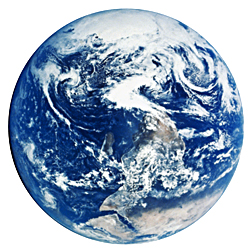PLANET EARTH
PLANET EARTH
- ATMOSPHERE
- OCEANS
- LAND
- ICE AND SNOW
- EARTH SCIENCE
- STUDY TECHNIQUES
- BIOSPHERE
- AXIS
- FIND OUT MORE
The rocky ball that forms our world is one of nine planets
in the Solar System. Earth is a sphere, with a slight bulge in the middle at
the Equator, and a diameter of 12,756 km (7,926 miles). It hurtles at speeds of
105,000 kph (65,000 mph) during its orbit around the Sun, turning on its
AXIS once every 24 hours. This journey takes a year to complete. The
Earth is the only planet that is known to support life, in a zone called
the
BIOSPHERE.
The atmosphere is a layer of gas surrounding the Earth that is some
700 km (400 miles) thick. It is made up of nitrogen (78 per cent) and oxygen
(21 per cent), plus traces of other gases. Tiny droplets of water vapour form
the clouds we see.
Oceans cover 70.8 per cent of the Earth’s surface, to an
average depth of 3.5 km (2 miles). The hydrosphere (watery zone) also includes
freshwater rivers and lakes, but these make up less than 1 per cent of
Earth’s water.
Dry land occupies 29.2 per cent of the Earth’s surface, where
the lithosphere (rocky crust) rises above sea level to form seven continents
and countless smaller islands. Land can be categorised into biomes –
major habitats such as forests, grasslands, and deserts.
The cryosphere (frozen zone) includes snow and glaciers on high
mountains, sea ice, and the huge ice caps that cover the landmasses of
Greenland and the Antarctic. In the past, during long cold eras called ice
ages, ice covered much more of Earth’s surface than it does today.
Meteorology, the study of Earth’s atmosphere, is one of the Earth
sciences. Earth scientists study Earth’s physical characteristics, from
raindrops to rivers and the rocks beneath our feet. Other branches of study
include geology (rocks), hydrology, (oceans and freshwater), and ecology
(living things and the environment).
Satellite images allow scientists to monitor everything from ocean
currents to minerals hidden below ground. Techniques such as radar and sonar
have transformed our understanding of our planet. Some Earth scientists also
spend time in the field, which means working outdoors, collecting data and
samples from clouds, cliffs, craters, volcanic lava, and deep-buried ice.
The biosphere is the part of Earth that contains what is
needed for living things. This zone extends from the ocean floor to top of the
troposphere (lower atmosphere). Tiny organisms can survive deep in the
Earth’s crust, but most forms of life are found from a few hundred
metres below sea level to about 1,000 m (3,300 ft) above sea
level.
Ozone is a gas spread thinly through the atmosphere. It filters
harmful ultraviolet (UV) rays from sunlight, while allowing visible light (the
light we can see) to pass through. Other gases in the atmosphere trap the
Sun’s heat when it is reflected from the Earth’s surface,
providing additional warmth for living things.
BIOGRAPHY: JAMES LOVELOCK British, 1919-
Environmental scientist James Lovelock argues that the planet can
be seen as a complete living organism, which he names Gaia, after the Greek
goddess of Earth. Gaia theory states that Earth itself balances conditions to
suit living things in the biosphere. This includes regulating the composition
of the atmosphere the chemistry of the oceans, and ground surface
temperature.
The ground beneath our feet may seem still, but in fact
the Earth is spinning like a top as it orbits the Sun. The Earth takes 24 hours
to rotate about its axis, an imaginary line running from the North Pole to the
South Pole through the centre of the Earth. The Earth’s axis is not at a
right-angle to the path of its orbit, but tilts at an angle of 23.5°.
The angle between each region of Earth and the Sun’s rays alters through
the year, producing seasonal changes in temperature and day length. These are
most noticeable in regions next to the poles, which are most distant from the
Equator.
As Earth turns about its axis, one half is bathed in sunlight and
experiences day, while the other half is plunged into darkness and has night.
The Earth always rotates eastward, so the Sun and stars appear to rise in the
east and set in the west. The tilt of the planet means that at any time, one
hemisphere (half of the Earth, as divided by the Equator) leans toward the Sun
and experiences summer, while the other leans away and has winter.

No comments:
Post a Comment